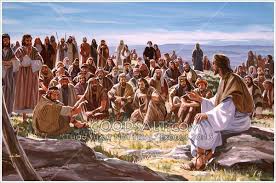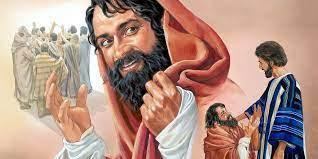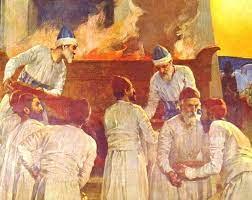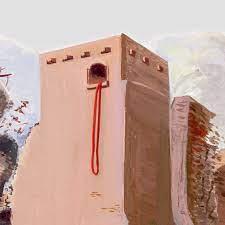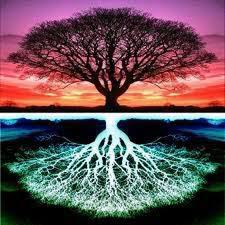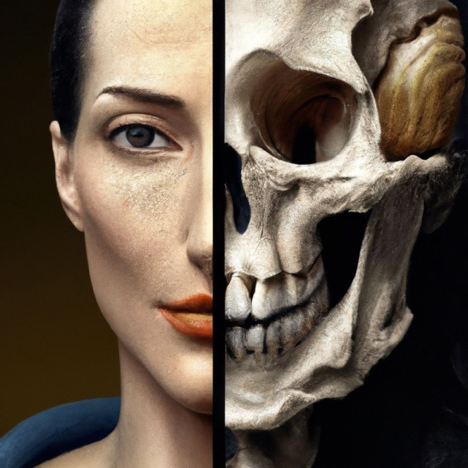Ct – पुत्र का अधिकार युहन्ना ५:१६-३०
पुत्र का अधिकार
युहन्ना ५:१६-३०
खोदाई: यूहन्ना ५:१-१५ में यीशु द्वारा अशक्त को ठीक करने का परिणाम क्या था? जिस तरह से उन्होंने यहूदी नेताओं को जवाब दिया उससे उनका विरोध कैसे और बढ़ गया? येशुआ ऐसा क्यों करेगा? मसीहा किस प्रकार पिता के समान है? दोनों के बीच संबंध प्रदर्शित करने के लिए किन शब्दों का उपयोग किया जाता है? यह यूहन्ना १:१ और १८ से कैसे संबंधित है? वचन २४ में येशुआ अपने बारे में क्या दावा करता है? वादा क्या है? कोई इस वादे पर कब अमल करना शुरू करता है? जो लोग सुनते हैं और विश्वास करते हैं उनका क्या होता है? उन लोगों के लिए जो नहीं करते? मनुष्य के पुत्र को न्यायाधीश क्यों होना चाहिए? वास्तव में ईश्वर मानवता को क्या प्रस्ताव दे रहा है?
विचार: यदि आपको किसी को अपने शब्दों में वचन २४ का अर्थ समझाना हो, तो आप कैसे समझाएँगे? यीशु के साथ अपने जीवन में, आपको यह सत्य कब समझ में आया? इसने आपकी आत्म-छवि को कैसे प्रभावित किया? क्या इससे आपकी जीवनशैली में कोई बदलाव आया? थोड़ा? बहुत? कितना? क्या इससे आपके जीवन के लक्ष्य प्रभावित हुए?
जब मसीहा ने शब्बत के दिन अशक्त को ठीक किया (देखें Cs – यीशु ने बेथेस्डा के तालाब में एक आदमी को ठीक किया), तो परिणाम अपरिहार्य था, यहूदी नेताओं ने उसे सताना शुरू कर दिया (युहन्ना ५:१६)। उनका विवाद केवल धर्मशास्त्रियों के बीच का झगड़ा नहीं था; मुद्दा अधिकार का था। उस चंगाई ने सवाल उठाया, “सब्त का मालिक कौन है?” फरीसी यहूदी धर्म ने यीशु द्वारा इन चीजों को करने पर आपत्ति जताते हुए शबात के स्वामित्व का दावा किया (उस विशिष्ट उपचार की तुलना में अनुग्रह के अधिक कार्य) जो कि मौखिक कानून (Ei – मौखिक कानून देखें) सातवें दिन मना करता है।
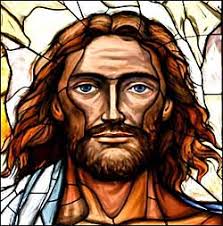 येशुआ के खिलाफ दो विशेष आरोप थे। सबसे पहले, सब्त के दिन बेथेस्डा के तालाब में अशक्त को ठीक करना। उन्होंने अपना बचाव यह बताते हुए शुरू किया कि येहोवा ने कभी भी काम करना बंद नहीं किया था। प्रभु ने उनसे कहा: मेरा पिता आज के दिन तक सदैव अपने काम पर है (यूहन्ना ५:१७ए)। फ़रीसी यहूदी धर्म का मानना था कि “कार्य” में किसी भी प्रकार की गतिविधि शामिल है। निर्गमन २०:११ के अनुसार, यहोवा ने आदेश दिया कि सातवें दिन इस्राएली कोई काम न करें क्योंकि उसने सृष्टि के छठे दिन के बाद विश्राम किया था। इसका उद्देश्य एलोहिम की दुनिया की रचना का सम्मान करना और उसके प्रावधान को याद रखना था। प्रभु ने काम करना बंद कर दिया क्योंकि उनकी रचना पूरी हो गई थी, और शब्बत हिब्रू क्रिया बंद करने पर आधारित है। हालाँकि, उन्होंने कभी भी प्रदान करना या सुरक्षा करना बंद नहीं किया! इस अर्थ में, परमेश्वर उनसे कभी विश्राम नहीं लेते। सूरज उगता है और डूब जाता है, ज्वार-भाटा उतरता और बहता है, बारिश होती है, हवा चलती है, साप्ताहिक विश्राम दिवस के साथ-साथ किसी अन्य दिन भी घास उगती है। उनकी कृपा के निरंतर कार्यों के बिना, सारी सृष्टि तुरंत नष्ट हो जाएगी।
येशुआ के खिलाफ दो विशेष आरोप थे। सबसे पहले, सब्त के दिन बेथेस्डा के तालाब में अशक्त को ठीक करना। उन्होंने अपना बचाव यह बताते हुए शुरू किया कि येहोवा ने कभी भी काम करना बंद नहीं किया था। प्रभु ने उनसे कहा: मेरा पिता आज के दिन तक सदैव अपने काम पर है (यूहन्ना ५:१७ए)। फ़रीसी यहूदी धर्म का मानना था कि “कार्य” में किसी भी प्रकार की गतिविधि शामिल है। निर्गमन २०:११ के अनुसार, यहोवा ने आदेश दिया कि सातवें दिन इस्राएली कोई काम न करें क्योंकि उसने सृष्टि के छठे दिन के बाद विश्राम किया था। इसका उद्देश्य एलोहिम की दुनिया की रचना का सम्मान करना और उसके प्रावधान को याद रखना था। प्रभु ने काम करना बंद कर दिया क्योंकि उनकी रचना पूरी हो गई थी, और शब्बत हिब्रू क्रिया बंद करने पर आधारित है। हालाँकि, उन्होंने कभी भी प्रदान करना या सुरक्षा करना बंद नहीं किया! इस अर्थ में, परमेश्वर उनसे कभी विश्राम नहीं लेते। सूरज उगता है और डूब जाता है, ज्वार-भाटा उतरता और बहता है, बारिश होती है, हवा चलती है, साप्ताहिक विश्राम दिवस के साथ-साथ किसी अन्य दिन भी घास उगती है। उनकी कृपा के निरंतर कार्यों के बिना, सारी सृष्टि तुरंत नष्ट हो जाएगी।
लेकिन पाखण्डी रब्बी इससे भी आगे निकल गया और उसने पिता के साथ अपनी पूर्ण समानता का दावा किया जब उसने कहा: और मैं भी काम कर रहा हूँ (यूहन्ना ५:१७बी)। यह शब्बत के स्वामित्व का पूर्ण दावा था। क्योंकि टोरा अडोनाई से आया है, टोरा ईश्वर की निंदा नहीं कर सकता। परमेश्वर का पुत्र बस वही कर रहा था जो वह, निर्माता के रूप में, सातवें दिन से कर रहा था। उसने वह किया था जो इब्राहीम, मूसा, डेविड या डैनियल ने कभी सपने में भी नहीं सोचा था। यहूदी नेताओं को बात समझ में नहीं आई।
दूसरा, स्वयं को ईश्वर के समकक्ष बनाना। इस कारण उन्होंने उसे मार डालने का और भी अधिक यत्न किया; वह न केवल सब्त का उल्लंघन कर रहा था, बल्कि वह परमेश्वर को अपना पिता भी कह रहा था, स्वयं को परमेश्वर के बराबर बना रहा था (योचनान ५:१८)। इस वचन में सभी क्रियाएँ अपूर्ण काल हैं, जो निरंतर क्रिया का वर्णन करती हैं। यह उन पंथों के साथ प्रयोग करने के लिए एक अच्छी कविता है जो मसीह के ईश्वरत्व को नकारते हैं। पंथ इस तर्क का उपयोग करते हैं कि कोई भी पुत्र पिता से कम होता है, इसलिए यदि यीशु केवल पुत्र होता, तो वह परमेश्वर से भी कम होता। यह सच्चा सज्जन तर्क हो सकता है, लेकिन यहूदी धर्म (संदर्भ, संदर्भ, संदर्भ) में, पहलौठा पिता के बराबर था! हमें पहली सदी के मूल सिट्ज़ इम लाबेन को समझने की जरूरत है। एक और तरीका जिससे पंथ मसीह के ईश्वरत्व को नकारते हैं, वह यह कहना है कि यीशु ने कभी नहीं कहा कि वह ईश्वर है। या फिर कभी ईश्वर होने का दावा नहीं किया. लेकिन इस परिच्छेद में यहूदी इस बारे में इतने भ्रमित नहीं थे कि वह क्या कह रहा था। बाप से समान सम्बन्ध रखते हुए जो एक करता है वही दूसरा करता है। यदि यह पुत्र का कार्य है, तो यह पिता का भी कार्य है। उन्होंने अपने अवैध अधिकार को उसकी चुनौती से नाराज कर दिया और उन्होंने एडोनाई के साथ समानता के उसके दावे को खारिज कर दिया। इसलिये उन्होंने उसे मार डालने का और भी अधिक प्रयत्न किया।
विवाद का असली मुद्दा यह था: सब्बाथ का मालिक कौन था? प्रभु ने उस प्रश्न का उत्तर छह विशिष्ट दावों के साथ दिया। सबसे पहले, राजाओं के राजा ने कहा, “मैं परमेश्वर के तुल्य हूँ।” येशु ने अपने ईश्वरत्व की सच्चाई को ऐसे शब्दों में प्रस्तुत किया कि उनके समय में कोई भी गलती नहीं कर सकता था। यीशु ने दोहरे आमीन के साथ शुरुआत की, जिसका अर्थ है कि यह सच है। मैं तुम से सच सच कहता हूं, पुत्र आप से कुछ नहीं कर सकता। इसका मतलब कोई दोष या सीमा नहीं है, इसका मतलब है कि बेटा पिता से स्वतंत्र रूप से कार्य नहीं कर सकता है। फिर उसने खुद को ईश्वर का पुत्र बताते हुए और ईश्वर को अपना पिता बताते हुए ईश्वर के साथ समानता का दावा किया। वह केवल वही कर सकता है जो वह अपने पिता को करते हुए देखता है, क्योंकि जो कुछ पिता करता है वही पुत्र भी करता है (यूहन्ना ५:१९)। जबकि पिता और पुत्र अलग-अलग व्यक्ति हैं, पिता और पुत्र एक ही परमेश्वर हैं। वैसे तो, पिता और पुत्र एक हैं; इसलिए, ट्रिनिटी के ये दो व्यक्ति (युहन्ना बाद में १६:१-१५ में पवित्र आत्मा की चर्चा करते हैं) एक दूसरे के विरोध में कार्य नहीं कर सकते। क्योंकि पिता पुत्र से प्रेम रखता है, और जो कुछ वह करता है उसे दिखाता है। हाँ, और वह उसे इन से भी बड़े काम दिखाएगा, कि तुम चकित हो जाओगे (यूहन्ना ५:२०)। पुत्र इस धरती पर मानव रूप में पिता का आदर्श प्रतिबिंब है। वह जो कुछ भी करता है वह पिता के इरादों और कार्यों को दर्शाता है।
दूसरा, जीवन की रोटी ने कहा, “मैं जीवन का दाता हूं।“ क्योंकि जैसे पिता मरे हुओं को जिलाता और जिलाता है, वैसे ही पुत्र भी जिसे वह देना चाहता है उसे जिलाता है (योचनान ५:२१)। जीवन देने में सक्षम होने के लिए, तुम्हें जीवन का स्रोत बनना होगा। तानाख में स्वयं ईश्वर के अलावा किसी ने भी जीवन देने का दावा नहीं किया। यह किसी भी सामान्य इंसान के लिए एक निंदनीय दावा होगा। मृत्यु को टालने के लिए चिकित्सक दवाएँ लिख सकते हैं या उपचार कर सकते हैं, लेकिन वे मृतकों को जीवन नहीं दे सकते। एडोनाई ने मृतकों को जीवित करने के लिए तानाख के भविष्यवक्ताओं का उपयोग किया था, लेकिन किसी ने भी इसका श्रेय लेने का साहस नहीं किया। केवल ईश्वर ही शून्य से कुछ बना सकता है: शुरुआत में ईश्वर ने आकाश और पृथ्वी की रचना की (उत्पत्ति १:१)। जब कोई प्रियजन मर जाता है तो हम कभी इतना असहाय महसूस नहीं करते। हम दवाएँ ला सकते हैं, आराम दे सकते हैं और प्रोत्साहन एवं सांत्वना प्रदान कर सकते हैं। शायद कुछ वित्तीय सहायता भी. लेकिन जब वह व्यक्ति मर जाता है तो हम केवल अपने नुकसान पर शोक मना सकते हैं। केवल ईश्वर के पास जीवन को बहाल करने की शक्ति है।
तीसरा, परमेश्वर के पुत्र ने कहा, “मैं अंतिम न्यायाधीश हूं।” तानाख में अंतिम निर्णय परमपिता परमेश्वर के लिए आरक्षित था। यदि अब पुत्र न्याय कर रहा है, तो पुत्र को परमेश्वर होना ही होगा। इसके अलावा, पिता किसी का न्याय नहीं करता है, बल्कि उसने सभी निर्णय पुत्र को सौंप दिए हैं (प्रकाशित Fo – महान सफ़ेद सिहासन की बिचार पर मेरी टिप्पणी देखें), और इसका कारण यह है कि सभी लोग पुत्र का उसी तरह सम्मान कर सकते हैं जैसे वे पिता का सम्मान करते हैं। जो कोई पुत्र का आदर नहीं करता, वह पिता का आदर नहीं करता, जिसने उसे भेजा (यूहन्ना ५:२२-२३)। केवल येशुआ ही हृदय के इरादों को पहचान सकता है, क्योंकि वह सर्वज्ञ है। केवल मसीह ही बिना दिखावे के किसी व्यक्ति का मूल्य तौल सकता है, क्योंकि वह पूर्णतः धर्मी है। केवल मास्टर बिल्डर ही हमारे भाग्य का फैसला कर सकता है, क्योंकि उसने हमें बनाया है और वह हम पर संप्रभु है। पिता परमेश्वर ने सारा न्याय पुत्र परमेश्वर को सौंप दिया है, क्योंकि पुत्र पिता के समान है। इस प्रकार, मसीह ने पिता के समान सम्मान का पात्र होने का दावा किया।
चौथा, पापियों के उद्धारकर्ता ने कहा, “मैं मानवता की शाश्वत नियति का निर्धारण करूंगा।” येशु के पास अनन्त जीवन प्रदान करने की शक्ति है। तानाख में जिसके पास अनन्त जीवन प्रदान करने की शक्ति थी वह केवल ईश्वर के लिए आरक्षित था। इसलिए यदि यीशु के पास यह शक्ति है, तो वह भी ईश्वर होगा। प्रभु ने एक बार फिर दोहरे आमीन के साथ अपने कथन को विराम दिया। आम तौर पर, पवित्र व्यक्ति ने स्वयं में विश्वास का आह्वान किया (यूहन्ना ३:१६); हालाँकि, इस मामले में उन्होंने पिता और पुत्र की पूर्ण एकता के विषय को सुदृढ़ करने के लिए पिता में विश्वास का आह्वान किया। एक पर विश्वास करना दूसरे पर विश्वास करना है। मैं तुम से सच सच कहता हूं, जो कोई मेरा वचन सुनता है और उस पर विश्वास करता है जिसने मुझे भेजा है, उसके पास अनन्त जीवन है (Ms देखें – आस्तिक की शाश्वत सुरक्षा) और उसका न्याय नहीं किया जाएगा, बल्कि वह मृत्यु से पार होकर जीवन में प्रवेश कर चुका है (यूहन्ना ५:२४) . हम कभी नहीं मरेंगे, हम केवल अपना पता ईश्वर की उपस्थिति में बदल देंगे। अनन्त जीवन केवल उचित आधार पर वर्तमान स्थिति हो सकता है। न्यायसंगत होने का अर्थ है धर्मी घोषित होना। हम शाश्वत रूप से धर्मी हैं क्योंकि जिस क्षण हम बचाए गए थे उस समय हम [पहले से ही] न्यायसंगत हो चुके थे (देखें Bw – विश्वास के क्षण में परमेश्वर हमारे लिए क्या करता है)।
कई विश्वासी क्रोधित ईश्वर का सामना करने की संभावना से डरते हैं; यह जानते हुए कि वह पवित्र है और हम पापी हैं। उन्होंने इस तथ्य को नहीं समझा है कि हम [पहले से ही] न्यायसंगत हो चुके हैं। यूनानी भाषा हमारे औचित्य की अवधारणा को बहुत स्पष्ट करती है। क्रियाओं की सटीकता के कारण, भाषा यह वर्णन करने में स्पष्ट है कि जब कुछ पहले ही किया जा चुका है (भूत काल), किया जा रहा है (वर्तमान काल), किया जाएगा (भविष्य काल), और एक सतत क्रिया है (अपूर्ण काल) . रोमियों ५:१ में, यह स्पष्ट रूप से कहता है कि हम अपने पवित्र पिता के समक्ष [पहले से ही] न्यायसंगत हो चुके हैं क्योंकि यीशु ने हमारे पापों के लिए दंड का भुगतान [पहले ही] कर दिया है, और परमेश्वर के साथ हमारी शांति स्थापित की है। रोमियों ५:१ का यूनानी पाठ डिकाइओथेंटेस से शुरू होता है, जिसका अर्थ है उचित ठहराया जाना। क्रिया एक परिणति सिद्धांतवादी, निष्क्रिय कृदंत है, जो किसी कार्य के पूरा होने पर जोर देती है, विशेष रूप से उससे निकलने वाले परिणामों पर। इसलिए, चूंकि हम विश्वास के माध्यम से उचित ठहराए गए हैं, हम [पहले से ही] हमारे प्रभु यीशु मसीह के माध्यम से परमेश्वर के साथ शांति रखते हैं (रोमियों ५:१)
जब कुछ [पहले से ही] किया जा चुका है, तो आपके पास करने के लिए कुछ नहीं बचता है। कई विश्वासी कुछ ऐसा बनने के लिए बेतहाशा प्रयास करते हैं जो वे पहले से ही हैं। बाइबल घोषित करती है कि आप अपने लिए वह नहीं कर सकते जो मसीह ने आपके लिए पहले ही कर दिया है। इसे कहने का दूसरा तरीका यह है कि जो मसीहा ने पहले ही कर दिया है उसे आप रद्द नहीं कर सकते। विरोधी का झूठ यह है कि आपको किसी प्रकार के कार्यों से अपने पापों का प्रायश्चित करना होगा और इस प्रकार ईश्वर के प्रति अपना प्रेम साबित करना होगा।
रोमन कैथोलिक चर्च ने एक सिद्धांत विकसित किया है जिसके अनुसार वे सभी जो पूर्ण नहीं हैं उन्हें मध्यवर्ती क्षेत्र में दंडात्मक और शुद्धिकरण पीड़ा से गुजरना होगा जिसे शुद्धिकरण के रूप में जाना जाता है। यह सिद्धांत इस धारणा पर आधारित है कि यद्यपि ईश्वर पाप क्षमा करता है, फिर भी उसका न्याय मांग करता है कि पापी को स्वर्ग में जाने से पहले पूरी सजा भुगतनी होगी। कैथोलिक चर्च के पवित्र पिताओं के अनुसार, अवधि को छोड़कर, शोधन की आग नरक की आग से भिन्न नहीं होती है। ऐसा कहा गया है कि कैथोलिक धर्म डर का धर्म है – पुजारी का डर, इकबालिया बयान का डर, गायब हुए जनसमूह के परिणामों का डर, तपस्या के अनुशासन का डर, मृत्यु का डर, शुद्धिकरण का डर, और का डर क्रोधित परमेश्वर का धर्मी न्याय।
हालाँकि, यह सारा डर अनावश्यक है क्योंकि मसीह ने [पहले से ही] विश्वास के साथ अपनी धार्मिकता हम पर थोप दी है (रोमियों ५:२-१९)। एक आध्यात्मिक बैंक खाते की तरह, मसीहा ने अपनी सारी धार्मिकता हम पर थोप दी है, या स्थानांतरित कर दी है। और परिणामस्वरूप, हम [पहले से ही] अपने विश्वास से न्यायसंगत हो चुके हैं। परिणामस्वरूप, जब प्रभु उद्धार के बाद हमारी ओर देखते हैं। वह हमारा पाप नहीं देखता. . . वह अपने बेटे को देखता है।
पाँचवाँ, चमत्कार करने वाले रब्बी ने कहा, “मैं मृतकों को जीवित करूँगा।” यीशु ही वह है जो मृतकों का पुनरुत्थान करेगा। तनाख़ में, केवल ईश्वर ने ही मृतकों का पुनरुत्थान किया। इसलिए यदि येशु मृतकों का पुनरुत्थान कर सकता है, तो वह अवश्य ही ईश्वर होगा। मैं तुम से सच सच कहता हूं, वह समय आ रहा है और अब भी आ गया है, जब मरे हुए लोग परमेश्वर के पुत्र की आवाज सुनेंगे (उनके ईश्वरत्व पर जोर देते हुए) और जो सुनेंगे वे जीवित हो जाएंगे। क्योंकि जैसे पिता अपने आप में जीवन रखता है, वैसे ही उस ने पुत्र को भी अपने आप में जीवन रखने की इजाज़त दी। और उसने उसे न्याय करने का अधिकार दिया है क्योंकि वह मनुष्य का पुत्र है (उसकी मानवता पर जोर देते हुए) (यूहन्ना ५:२५-२७)। प्रभु ने समस्त मानवता का न्याय करने की अपनी योग्यता को मान्य किया क्योंकि वह ईश्वर का पुत्र है, जो जीवन दे सकता है, और मनुष्य का पुत्र भी है, जिसने एक मानव के रूप में जीवन का अनुभव किया, फिर भी पाप के बिना।
एक समय आ रहा है जब हर कोई यीशु की आवाज़ सुनेगा। एक दिन जब बाकी सभी आवाजें खामोश हो जाएंगी; उसकी आवाज़ – और केवल उसकी आवाज़ – सुनी जाएगी। कुछ लोग पहली बार उसकी आवाज़ सुनेंगे। ऐसा नहीं है कि उन्होंने कभी बात नहीं की, बात सिर्फ इतनी है कि उन्होंने कभी नहीं सुनी। इनके लिए, परमेश्वर की आवाज़ एक अजनबी की आवाज़ होगी। वे इसे एक बार सुनेंगे – और फिर कभी नहीं सुनेंगे। वे पृथ्वी पर “उस आवाज़” का विरोध करते हुए अनंत काल बिताएंगे जिसका उन्होंने अनुसरण किया था। लेकिन दूसरों को उनकी कब्रों से एक परिचित आवाज से बुलाया जाएगा। क्योंकि वे भेड़ें हैं जो अपने चरवाहे को जानती हैं। वे सेवक हैं जिन्होंने पवित्र आत्मा के दस्तक देने पर दरवाज़ा खोला। किसी दिन वह दरवाज़ा फिर खुलेगा। केवल इस बार, यह यीशु नहीं होगा जो हमारे घर में आएगा; यह हम ही होंगे, जो उसके पास चलेंगे। युहन्ना ५:२८-२९ में प्रभु ने यहूदी नेताओं से कहा: इस पर आश्चर्यचकित मत हो, क्योंकि वह समय आ रहा है जब सभी जो अपनी कब्रों में हैं, उसकी आवाज सुनेंगे, और बाहर आओ – जिन्होंने अच्छा किया है (याकूब २:१४-२६) वे जीवित रहने के लिए उठ खड़े होंगे (देखें रहस्योद्घाटन Fn पर मेरी टिप्पणी – पहला पुनरुत्थान), और जिन्होंने बुरा किया है वे निंदा के लिए उठ खड़े होंगे (देखें) रेव एफएन – द सेकेंड रिसरेक्शन पर मेरी टिप्पणी)।
छठा, येशुआ बेन डेविड ने कहा, “मैं हमेशा एलोहीम की इच्छा पूरी कर रहा हूं।” मसीहा के अंतिम दावे में उसने पृथ्वी पर अपने कार्यों को स्वर्ग में अपने पिता की इच्छा से जोड़ा। अब परिप्रेक्ष्य में अचानक बदलाव आया है। यहूदी धार्मिक नेताओं के साथ अपने टकराव के दौरान, गैलीलियन रब्बी ने ईश्वर के पुत्र और मनुष्य के पुत्र जैसे शीर्षकों का उपयोग करते हुए खुद को तीसरे व्यक्ति के रूप में संदर्भित किया। लेकिन जैसे ही वह अपने और यहूदी नेताओं के बीच टकराव के अगले चरण में परिवर्तित हुआ (देखें सीयू – यदि आप मूसा पर विश्वास करते, तो आप मुझ पर विश्वास करते), वह वचन १९ से अपने मूल दावे को दोहराता है, केवल पहले व्यक्ति में बोलता है: मेरे द्वारा मैं कुछ नहीं कर सकता; मैं जैसा सुनता हूं वैसा ही न्याय करता हूं, और मेरा न्याय न्यायपूर्ण है, क्योंकि मैं अपने आप को नहीं, परन्तु अपने भेजनेवाले को प्रसन्न करना चाहता हूं (योचनान ५:३०)। उनकी बात बिल्कुल स्पष्ट थी, वह किसी और की बात नहीं कर रहे थे; वह अपने बारे में दावे कर रहा था. इससे उनके विरोधियों के पास समझौते के लिए कोई जगह नहीं बची, उनके पास खड़े होने के लिए कोई बीच का रास्ता नहीं बचा। और वही आज हमारे लिए भी लागू होता है। हमें उनकी घोषणा को स्वीकार या अस्वीकार करना चाहिए।
प्रिय स्वर्गीय पिता, मैं आपको कीमत चुकाने के लिए अपने इकलौते बेटे को भेजने के लिए धन्यवाद देता हूं ताकि मैं न्यायसंगत हो सकूं। मैं अब विश्वास से स्वीकार करता हूं कि मेरे प्रभु यीशु मसीह के माध्यम से मुझे आपके साथ शांति है। मैं इस झूठ को त्यागता हूं कि हम दुश्मन हैं और इस सच्चाई का दावा करता हूं कि हम दोस्त हैं, आपके बेटे की मौत से सुलह हो गई है। मैं उस जीवन में आनन्दित हूं जो अब मेरे पास मसीहा में है और मैं उस दिन का इंतजार कर रहा हूं जब मैं आपको आमने-सामने देखूंगा। येशुआ के अनमोल नाम में मैं प्रार्थना करता हूं। आमीन, वह विश्वासयोग्य है।



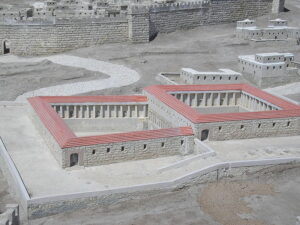 उस दिन येशुआ के दिमाग में दो बिल्कुल अलग तस्वीरें थीं। एक तरफ, बड़ी संख्या में अपाहिज, अंधे, लंगड़े और लकवाग्रस्त लोग लेटे हुए थे, और पानी के हिलने की प्रतीक्षा कर रहे थे (योचनान ५:३)। उनकी पीड़ाएँ और झूठी उम्मीदें रोटी के लिए भूखे लोगों की चीख की तरह उभरीं। और दूसरी तरफ, पड़ोसी मंदिर, अपने पुरोहितों और शिक्षकों के साथ, जो मौखिक कानून के अपने स्वार्थी धर्म में (
उस दिन येशुआ के दिमाग में दो बिल्कुल अलग तस्वीरें थीं। एक तरफ, बड़ी संख्या में अपाहिज, अंधे, लंगड़े और लकवाग्रस्त लोग लेटे हुए थे, और पानी के हिलने की प्रतीक्षा कर रहे थे (योचनान ५:३)। उनकी पीड़ाएँ और झूठी उम्मीदें रोटी के लिए भूखे लोगों की चीख की तरह उभरीं। और दूसरी तरफ, पड़ोसी मंदिर, अपने पुरोहितों और शिक्षकों के साथ, जो मौखिक कानून के अपने स्वार्थी धर्म में (
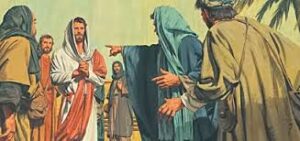
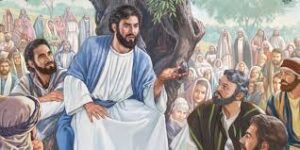
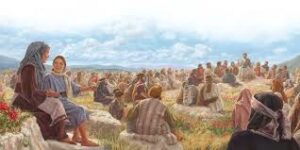 हालाँकि येशु पहाड़ पर बड़ी भीड़ के सामने बोल रहे थे, राज्य जीवन के बारे में उनकी शिक्षा मुख्य रूप से उनके शिष्यों के लिए थी, उन लोगों के लिए जो उस पर विश्वास करते थे। प्रभु की चिंता सभी लोगों के लिए थी, और राज्य की धार्मिकता पर उनकी शिक्षा सुनकर उनमें से कई लोग विश्वास की ओर आकर्षित हुए होंगे। लेकिन उन्होंने जो सिद्धांत सिखाए वे केवल विश्वासियों पर लागू होते थे, क्योंकि रुआच हाकोडेश की शक्ति के बिना उन सिद्धांतों का पालन करना असंभव है। उसके शिष्यों की एक बड़ी भीड़ वहां थी और पूरे यहूदिया, यरूशलेम और सूर और सैदा के आसपास के तटीय क्षेत्र से बड़ी संख्या में लोग थे (मत्ती ५:१; लूका ६:१७), जो उसे सुनने आए थे और उनकी बीमारियों से ठीक होने के लिए. बड़ी संख्या में लोगों का उल्लेख उस समय यीशु के मंत्रालय की लोकप्रियता की ओर इशारा करता है। ईसा मसीह ने जिस धार्मिकता की बात की थी और फरीसी यहूदी धर्म की धार्मिकता स्पष्ट रूप से बहुत अलग थी। और उनके मंत्रालय के उपचार पहलू से अलग, कई लोग आंतरिक धार्मिकता के प्यासे थे जो येरुशलायिम में उनके धार्मिक नेताओं द्वारा समर्थित बाहरी औपचारिकता से स्पष्ट रूप से अलग था।
हालाँकि येशु पहाड़ पर बड़ी भीड़ के सामने बोल रहे थे, राज्य जीवन के बारे में उनकी शिक्षा मुख्य रूप से उनके शिष्यों के लिए थी, उन लोगों के लिए जो उस पर विश्वास करते थे। प्रभु की चिंता सभी लोगों के लिए थी, और राज्य की धार्मिकता पर उनकी शिक्षा सुनकर उनमें से कई लोग विश्वास की ओर आकर्षित हुए होंगे। लेकिन उन्होंने जो सिद्धांत सिखाए वे केवल विश्वासियों पर लागू होते थे, क्योंकि रुआच हाकोडेश की शक्ति के बिना उन सिद्धांतों का पालन करना असंभव है। उसके शिष्यों की एक बड़ी भीड़ वहां थी और पूरे यहूदिया, यरूशलेम और सूर और सैदा के आसपास के तटीय क्षेत्र से बड़ी संख्या में लोग थे (मत्ती ५:१; लूका ६:१७), जो उसे सुनने आए थे और उनकी बीमारियों से ठीक होने के लिए. बड़ी संख्या में लोगों का उल्लेख उस समय यीशु के मंत्रालय की लोकप्रियता की ओर इशारा करता है। ईसा मसीह ने जिस धार्मिकता की बात की थी और फरीसी यहूदी धर्म की धार्मिकता स्पष्ट रूप से बहुत अलग थी। और उनके मंत्रालय के उपचार पहलू से अलग, कई लोग आंतरिक धार्मिकता के प्यासे थे जो येरुशलायिम में उनके धार्मिक नेताओं द्वारा समर्थित बाहरी औपचारिकता से स्पष्ट रूप से अलग था।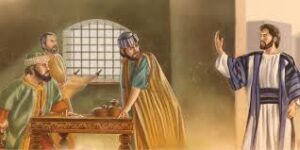 तब पापियों के उद्धारकर्ता ने उससे कहा:
तब पापियों के उद्धारकर्ता ने उससे कहा: 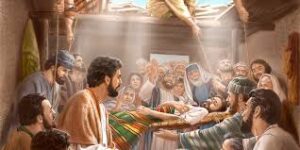 लेकिन जब तक उसके दोस्त आये, घर भर चुका था। लोगों ने दरवाजे जाम कर दिये. बच्चे खिड़कियों में बैठे थे. दूसरों ने कंधे से कंधा मिलाकर देखा। वे कभी यीशु का ध्यान कैसे आकर्षित करेंगे? उन्हें एक विकल्प चुनना था. क्या वे कोई रास्ता खोजेंगे या हार मान लेंगे। जब उन्हें ऐसा करने का कोई रास्ता नहीं मिला क्योंकि फरीसियों ने द्वार को अवरुद्ध कर दिया था, तो वे छत पर चढ़ गये। उन दिनों, पूर्वी छत सपाट थी, और घर के बरामदे के रूप में काम करती थी। वहाँ आम तौर पर एक बाहरी सीढ़ी थी और वे लकवाग्रस्त व्यक्ति को छत तक ले जाने में कामयाब रहे। इसमें अपने आप में काफी मेहनत लगेगी। परन्तु फिर उन्होंने येशुआ के ठीक ऊपर खुदाई करके एक खुला स्थान बनाया। इसका मतलब था छत पर फैली मोटर, तारकोल, राख और रेत को खोदना। तब उन्होंने उस व्यक्ति को उसकी खाट पर लिटा कर भीड़ के बीच में, यीशु के ठीक सामने, जो उपदेश दे रहा था, उतार दिया (मत्ती ९:२क; मरकुस २:३-४; लूका ५:१८-१९)। क्या प्रवेश द्वार है!
लेकिन जब तक उसके दोस्त आये, घर भर चुका था। लोगों ने दरवाजे जाम कर दिये. बच्चे खिड़कियों में बैठे थे. दूसरों ने कंधे से कंधा मिलाकर देखा। वे कभी यीशु का ध्यान कैसे आकर्षित करेंगे? उन्हें एक विकल्प चुनना था. क्या वे कोई रास्ता खोजेंगे या हार मान लेंगे। जब उन्हें ऐसा करने का कोई रास्ता नहीं मिला क्योंकि फरीसियों ने द्वार को अवरुद्ध कर दिया था, तो वे छत पर चढ़ गये। उन दिनों, पूर्वी छत सपाट थी, और घर के बरामदे के रूप में काम करती थी। वहाँ आम तौर पर एक बाहरी सीढ़ी थी और वे लकवाग्रस्त व्यक्ति को छत तक ले जाने में कामयाब रहे। इसमें अपने आप में काफी मेहनत लगेगी। परन्तु फिर उन्होंने येशुआ के ठीक ऊपर खुदाई करके एक खुला स्थान बनाया। इसका मतलब था छत पर फैली मोटर, तारकोल, राख और रेत को खोदना। तब उन्होंने उस व्यक्ति को उसकी खाट पर लिटा कर भीड़ के बीच में, यीशु के ठीक सामने, जो उपदेश दे रहा था, उतार दिया (मत्ती ९:२क; मरकुस २:३-४; लूका ५:१८-१९)। क्या प्रवेश द्वार है!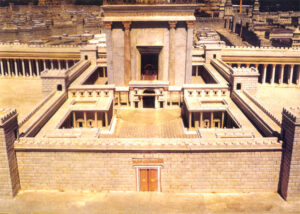 पुजारियों
पुजारियों यूनानी पाठ हमें एक अद्भुत उत्तर देता है। इस निर्माण को नियंत्रित करने वाले ग्रीक व्याकरण का नियम कहता है कि वर्तमान काल कृदंत की क्रिया अग्रणी क्रिया की क्रिया के साथ-साथ चलती है। तो जब यीशु ने कहा:
यूनानी पाठ हमें एक अद्भुत उत्तर देता है। इस निर्माण को नियंत्रित करने वाले ग्रीक व्याकरण का नियम कहता है कि वर्तमान काल कृदंत की क्रिया अग्रणी क्रिया की क्रिया के साथ-साथ चलती है। तो जब यीशु ने कहा: 